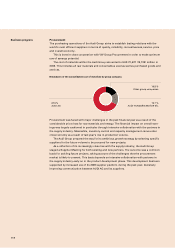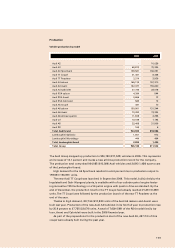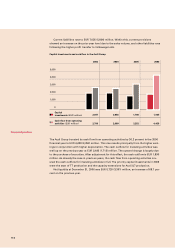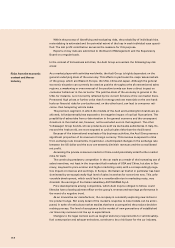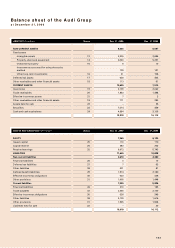Audi 2006 Annual Report Download - page 156
Download and view the complete annual report
Please find page 156 of the 2006 Audi annual report below. You can navigate through the pages in the report by either clicking on the pages listed below, or by using the keyword search tool below to find specific information within the annual report.
1 5 4
Within the process of identifying and evaluating risks, the probability of individual risks
materialising is estimated and the potential extent of the loss in each individual case quanti-
fied. The lost profit contribution serves as the measure for this purpose.
Reports on key risks are submitted to the Board of Management and the Supervisory
Board on a regular basis.
In the context of its business activities, the Audi Group encounters the following key risk
areas:
As a market player with activities worldwide, the Audi Group is highly dependent on the
general underlying state of the economy. This affects in particular the major sales markets
of the group, which are Western Europe, the USA, China and Japan. Although the general
economic situation can currently be rated as positive throughout the aforementioned sales
regions, a weakening or even reversal of the positive trends can have a direct impact on
consumer behaviour in the car sector. The positive state of the economy in general in the
USA, for instance, is not currently reflected by the current fortunes of the car market there.
Protracted high prices or further price rises for energy and raw materials on the one hand
harbour financial risks for production and, on the other hand, can lead to consumer reti-
cence, thus hampering vehicle sales.
The premium segment, in which the models of the Audi and Lamborghini brands are po-
sitioned, is fundamentally less exposed to the negative impact of cyclical fluctuations. The
possibility of sales risks from a deterioration in the general economy and the consequent
downturn in the market can, however, not be excluded even in that segment. The other
Volkswagen Group brands, whose products are sold via Audi sales subsidiaries in Italy, Ko-
rea and the Arab world, are more exposed to cyclical sales risks than the Audi brand.
Because of the international emphasis of its business activities, the Audi Group earns a
significant proportion of its revenue in foreign currency. This revenue is exposed to risks
from exchange rate movements. In particular, unanticipated changes in the exchange rate
between the US dollar and the euro can severely diminish revenues and the consolidated
net profit.
Accessing the private consumer market in China could potentially entail further market
risks for Audi.
The continuing predatory competition in the car trade as a result of the increasing use of
sales incentives, not least in the important Audi markets of USA and China, but also in Ger-
many, may lead to price erosion and higher marketing costs, with a correspondingly nega-
tive impact on revenue and earnings. In Europe, the Italian car market in particular has been
dominated by an exceptionally high level of sales incentives for some time now. This unfa-
vourable development, which could lead to a considerable rise in marketing costs, may
diminish the earnings of the Italian subsidiary AUTOGERMA S.p.A.
Price developments among competitors, which Audi may be obliged to follow, could
likewise have a lasting adverse effect on the group’s revenue and earnings performance in
the event of a negative trend.
As an innovative car manufacturer, the company is constantly exploring new niches in
the product range. Not every detail of the market’s response to new models can be antici-
pated, in spite of meticulous market studies that have accompanied the product decision-
making process. The level of acceptance by the market of new generations of established
car lines may moreover not live up to expectations.
Changes to the legal context, such as tougher statutory requirements for vehicle safety,
fuel consumption and exhaust emissions, continue to be a risk factor for the car industry.
Risks from the economic
context and the car
industry


